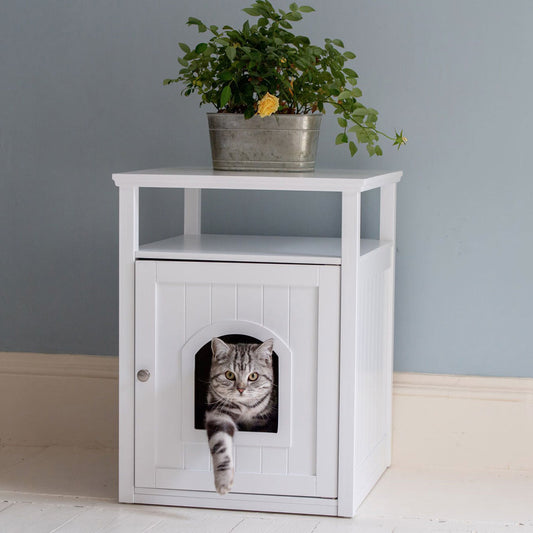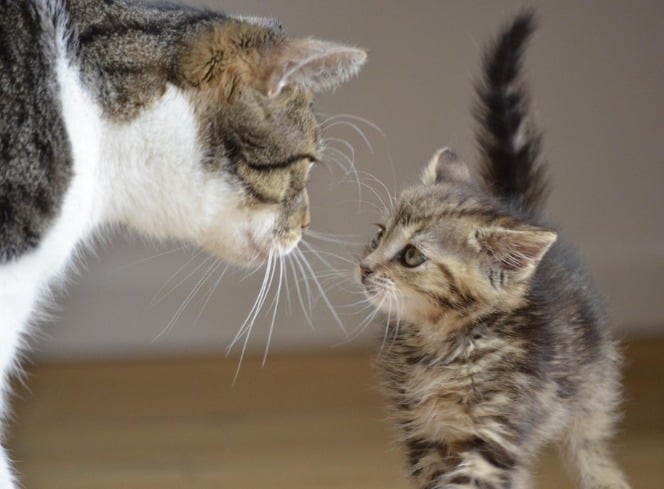Waiting to bring home your new kitten is super exciting! Whether your new furry friend is a Pedigree or Moggy, there are a number of necessities you will need to have ready, in preparation for their arrival home.
What litter tray is best for kittens?
Litter Tray – Litter training your kitty is essential, not just for indoor cats but for outdoor cats too. Buy a good quality litter (we like clumping litter as it tends to have no odour and is more economical) and a litter scoop for cleaning. If you’d like something that looks more attractive than a regular litter tray, our Cat Washroom is ideal – a stylish piece of furniture that hides your litter tray away.
The best bed for my kitten
You will need a Cosy Cat Bed for your furry friends arrival (and all cats love to snooze!) In fact, a cat will sleep around 15 hours a day; up to 20 for kittens! With this in mind a cosy cat bed is a must-have. There are a number of options from cosy caves and hooded designs to radiator beds.
What does my kitten need?
Cat Food & Water Bowls – A regular feeding regime is important for your growing kitten. Make sure you have at least two bowls for food and water. Keep dry food and fresh water available throughout the day. You may add a third, so you have separate bowls for wet and dry food. If you are getting your kitten from a breeder, speak to them about what food they recommend; they may give you a small amount when you collect your little one. There are a lot of resources online about cat food and what to feed them, but as long as you choose a good quality food especially for kittens you can’t go wrong. We’d also recommend feeding them both dry and wet food. The former is good to keep down all day for them to graze on and will help keep their teeth healthy. The latter is good for their digestion and water works and will help keep their fluid intake up – not all cats love drinking water. Aim for two small portions per day (check the individual food packaging for portion recommendations).
Cat Carrier – Regular trips to the Vet will ensure your cat is healthy. After their initial vaccinations, they will need a yearly trip to top them up. A carrier will allow you to travel with your cat in safety. We particularly like the Catit Cabrio as it opens fully from the top allowing for easy access to nervous kittens. There are a number of other styles and designs to choose from though.
Scratch Post or Tree – All cats love to eat, play, sleep and…. Scratch! Rather than discourage from scratching you should encourage them to do it in the correct places. Scratching is a healthy habit which will keep your cats claws healthy; removing the dead husks as they grow out, and also allows them to stretch out their muscles – cats are athletic creatures by nature, so a good stretch is great way to keep their muscles in tip-top shape! As a kitten you may wish to choose a small compact scratch post, but as they grow think about choosing a tall post that they can really stretch against as they scratch. A tall cat tree with a series of posts and platforms is great if you have the room as it will appeal to your cat’s love for climbing – also a great idea for indoor cats as it will help keep them active and their weight under control.
Cat Collar – This isn’t necessarily an essential for all cats, but if you’re kitten will one day venture outside you may wish to give them a collar. Collars can be adorned with an I.D tag so if your cat gets stuck up a tree or roams too far from home then hopefully someone will be able to bring them home. If you do choose to collar your cat, do your research and ensure you choose one with a breakaway collar in case it gets caught on your cat travels.
Cat Toys –Playtime is good for kittens’ development so toys are an essential on your kitten shopping list. Think about a series of toys that will appeal to your cats hunting instinct. Catnip mice and balls are always a favourite, but also think about teaser wand toys and something interactive. Our top pick would be a toy or two from the Catit Senses range. The Senses 2.0 range is designed to fulfil every one of your cat’s unique senses (hence the name) and can be used as separate items or connected together as a set.
Grooming Kit – Different breeds will have different grooming requirements. A soft brush is a good addition to every cat owner’s accessories, but if you are bringing home a long-haired breed then you will need an array of tools to help keep their coat in tip-top condition. We stock a number of ancol brushes and combs for everyday grooming, but if you’re looking for the ultimate grooming kit then take a look at the Catit kits, one for longhaired breeds and one for shorthaired breeds, they contain everything you will need to keep your cat looking beautiful.
Microchip your cat – Not really an item for your shopping list, but an absolute must for all pet owners (cat and dog alike, both indoor and outdoor pets). Even if you intend to collar your cat you should microchip your pet so they can be traced properly.
Of course this is just a guide to the necessities you should think about in advance of bringing your kitten home, rather than a definitive list. Have a browse, speak to your breeder if you’re getting a pedigree and select the things that you think will best suit you and your lifestyle. If you have any questions, do get in touch.; we’re always happy to help!































































































